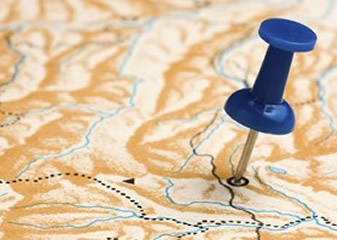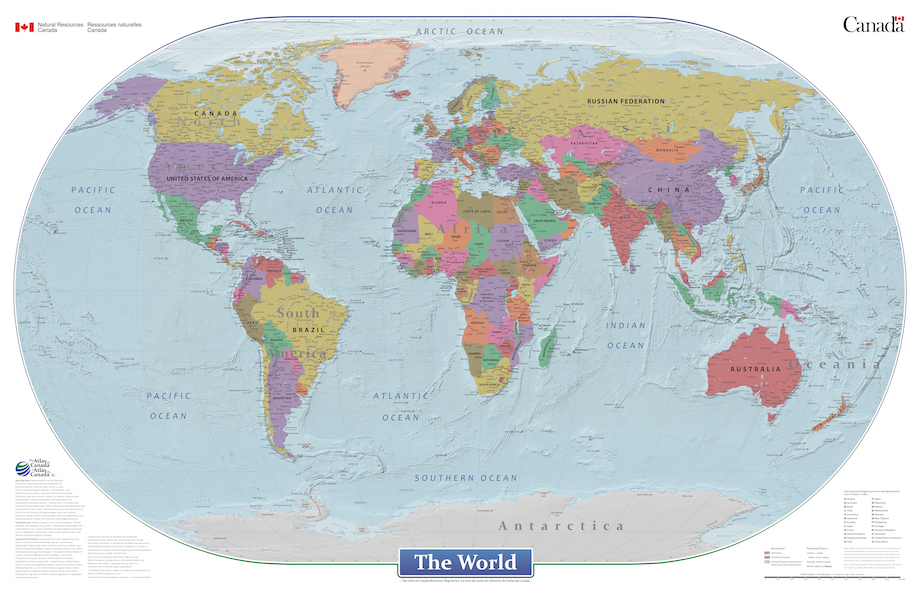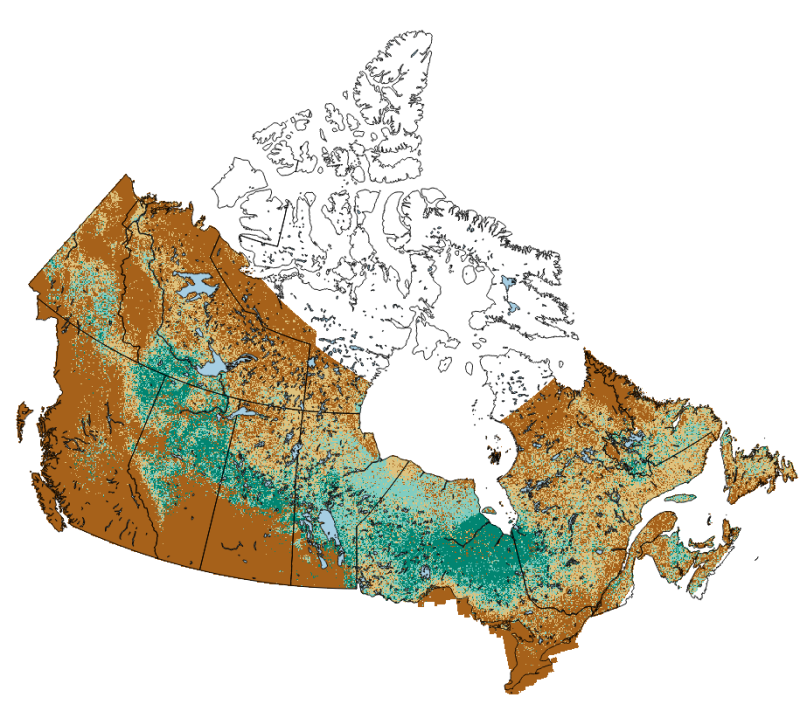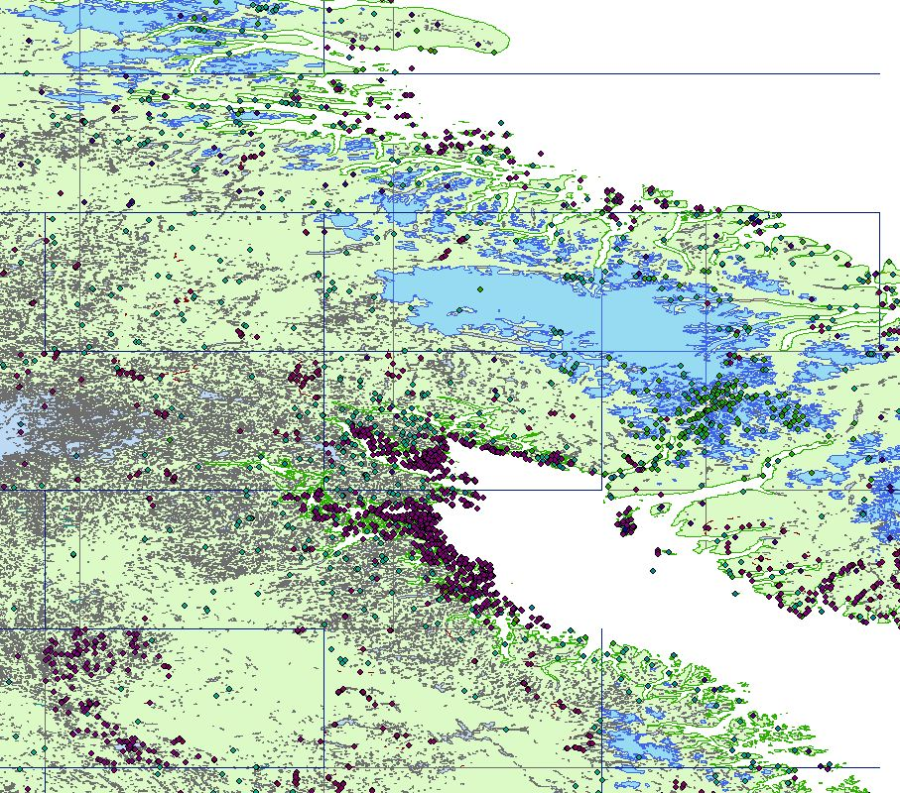Geographical maps
Type of resources
Available actions
Topics
Keywords
Contact for the resource
Provided by
Formats
Representation types
Update frequencies
status
Scale
Resolution
-

Map shows the geography of the northern circumpolar region, north of approximately 55 degrees latitude. This product is derived from the Atlas of Canada's bilingual wall map "The Circumpolar Region - North" (MCR 0001). To limit the impact of aliasing of the annotation we rendered the map into two tiled web services with a service showing the 'base' information and the other the 'annotation.' Combined the two services more or less replicate the wall map online. In addition to the tiled services, the mxd and geodatabase in FGDB format are available for download. Note: Since the geodatabase was derived from a cartographic product not all features have attribute information even though they are labelled on the map. The map uses the azimuthal equidistant projection. Displayed on the map are the international boundaries, as well as the Canadian provincial and territorial boundaries, all current to 2014. Also shown are national capital cities, other cities, towns, villages and hamlets along with some seasonally populated places. The map identifies a number of significant northern features, including the median sea ice extent from September 1981 to 2010, the tree line, undersea relief, land relief, glaciers, ice fields and coastal ice shelves. Labelled are many of the physiographic and hydrographic features.
-

This collection is a legacy product that is no longer supported. It may not meet current Government standards. The National Topographic Data Base (NTDB) comprises digital vector data sets that cover the entire Canadian landmass. The NTDB includes features such as watercourses, urban areas, railways, roads, vegetation, and relief. The organizational unit for the NTDB is the National Topographic System (NTS), based on the North American Datum of 1983 (NAD83). Each file (data set) consists of one NTS unit at either the 1:50,000 or 1:250,000 scale. Related Products: [NTDB Correction Matrices, 2003-2009](https://ouvert.canada.ca/data/en/dataset/b6d0c19c-27e3-4392-b21f-49b1eec95653)
-

Reference maps illustrate the location of census standard geographic areas for which census statistical data are tabulated and disseminated. The maps display the boundaries, names and unique identifiers of standard geographic areas, as well as physical features such as streets, railroads, coastlines, rivers and lakes. Reference maps include: Standard Geographical Classification (SGC) Census tracts Federal electoral districts
-

This interactive map is a collaborative project by Natural Resources Canada and the federal, provincial and territorial members of the Geographical Names Board of Canada. The map illustrates a sample of close to 500 places in Canada named for women from a range of backgrounds who have been remembered for many different reasons. Each point on the map is categorized by a theme, and contains a short description of the person behind that place name. The descriptions reveal that information about these women and the places named for them varies widely; some are well-known and well-documented figures, while little is known about others.
-

This cartographic digital product is derived from the Atlas of Canada's wall map "The World" (MCR 0046) and "Le monde" (MCR 0046F) published in 2021. The World is a general reference political map focused on the names and international boundaries of sovereign and non-sovereign countries. The information is portrayed using the Winkel II projection at a scale of 1:29 000 000. The dataset includes international boundaries, populated places, and labelled major hydrographic and physical features. In the geodatabase the representation of political boundaries do not necessarily reflect the position of the Government of Canada on all international issues of recognition, sovereignty or jurisdiction; some of the populated places have seasonal populations, while others are research or military bases with no permanent populations; and, there are no attribute information in the geodatabase for the labelled hydrographic and physical features.
-
Salmon have a complex hierarchical population structure extending from groups of salmon at individual spawning sites all the way up to taxonomic species. These independently functioning aggregates are defined as Conservation Units (CUs) in the Wild Salmon Policy. A stock management unit (SMU) is a group of one or more CUs that are managed together with the objective of achieving a joint status. There are 69 SMUs containing 468 CUs. In 2022, eight SMUs units did not have enough information to provide an assessment. Sixty-one units were assigned a forecast. There are ongoing requests to represent salmon information for these areas. Salmon are assessed and managed at different levels for different needs. The layers in this dataset include administrative areas, stock management units, and conservation units. The data included is a shapefile containing a single feature class layer represented in point and polygon form, as well as a csv table (attributes) to present Stock Management Unit information in a simple, visual way.
-
Collection of Land Cover products for Canada as produced by Natural Resources Canada using Landsat satellite imagery. This collection of cartographic products offers classified Land Cover of Canada at a 30 metre scale, updated on a 5 year basis. - [Landcover of Canada 2010](https://open.canada.ca/data/en/dataset/c688b87f-e85f-4842-b0e1-a8f79ebf1133) - [Landcover of Canada 2015](https://open.canada.ca/data/en/dataset/4e615eae-b90c-420b-adee-2ca35896caf6) - [Landcover of Canada 2020](https://open.canada.ca/data/en/dataset/ee1580ab-a23d-4f86-a09b-79763677eb47)
-

Organic soils in the boreal forest commonly store as much carbon as the vegetation above ground. While recent efforts through the National Forest Inventory has yielded new spatial datasets of forest structure across the vast area of Canada’s boreal forest, organic soils are poorly mapped. In this geospatial dataset, we produce a map primarily of forested and treed peatlands, those with more than 40 cm of peat accumulation and over 10% tree canopy cover. National Forest Inventory ground plots were used to identify the range of forest structure that corresponds to the presence of over 40 cm of peat soils. Areas containing that range of forest cover were identified using the National Forest Inventory k-NN forest structure maps and assigned a probability (0-100% as integer) of being a forested or treed peatland according to a statistical model. While this mapping product captures the distribution of forested and treed peatlands at a 250 m resolution, open, completely treeless peatlands are not fully captured by this mapping product as forest cover information was used to create the maps. The methodology used in the creation of this product is described in: Thompson DK, Simpson BN, Beaudoin A. 2016. Using forest structure to predict the distribution of treed boreal peatlands in Canada. Forest Ecology and Management, 372, 19-27. https://cfs.nrcan.gc.ca/publications?id=36751 This distribution uses an updated forest attribute layer current to 2011 from: Beaudoin A, Bernier PY, Villemaire P, Guindon L, Guo XJ. 2017. Species composition, forest properties and land cover types across Canada’s forests at 250m resolution for 2001 and 2011. Natural Resources Canada, Canadian Forest Service, Laurentian Forestry Centre, Quebec, Canada. https://doi.org/10.23687/ec9e2659-1c29-4ddb-87a2-6aced147a990 Additionally, this distribution varies slightly from the original published in 2016 in that here slope data is derived from the CDEM: https://open.canada.ca/data/en/dataset/7f245e4d-76c2-4caa-951a-45d1d2051333 The above peatland probability map was further processed to delineate bogs vs fens (based on mapped Larix content via the k-NN maps), as well as an approximation of the extent of open peatlands using EOSD data. The result is a 9-type peatland map with a more complete methodology as detailed in: Webster, K. L., Bhatti, J. S., Thompson, D. K., Nelson, S. A., Shaw, C. H., Bona, K. A., Hayne, S. L., & Kurz, W. A. (2018). Spatially-integrated estimates of net ecosystem exchange and methane fluxes from Canadian peatlands. Carbon Balance and Management, 13(1), 16. https://doi.org/10.1186/s13021-018-0105-5 In plain text, the legend for the 9-class map is as follows: value="0" label="not peat" alpha="0" value="1" label="Open Bog" alpha="255" color="#0a4b32" value="2" label="Open Poor Fen" alpha="255" color="#5c5430" value="3" label="Open Rich Fen" alpha="255" color="#792652" value="4" label="Treed Bog" alpha="255" color="#6a917b" value="5" label="Treed Poor Fen" alpha="255" color="#aba476" value="6" label="Treed Rich Fen" alpha="255" color="#af7a8f" value="7" label="Forested Bog" alpha="255" color="#aad7bf" value="8" label="Forested Poor Fen" alpha="255" color="#fbfabc" value="9" label="Forested Rich Fen" alpha="255" color="#ffb6db" This colour scale is given in qml/xml format in the resources below. The 9-type peatland map from Webster et al 2018 was further refined slightly following two simple conditions: (1) any 250-m raster cell with greater than 40% pine content is classified as upland (non-peat); (2) all 250-m raster cells classified as water or agriculture via the NRCan North American Land Cover Monitoring System (https://doi.org/10.3390/rs9111098) is also classified as non-peatland (value of zero in the 9-class map. This mapping scheme was used at a regional scale in the following paper: Thompson, D. K., Simpson, B. N., Whitman, E., Barber, Q. E., & Parisien, M.-A. (2019). Peatland Hydrological Dynamics as A Driver of Landscape Connectivity and Fire Activity in the Boreal Plain of Canada. Forests, 10(7), 534. https://doi.org/10.3390/f10070534 And is reproduced here at a national scale. Note that this mapping product does not fully capture all permafrost peatland features covered by open canopy spruce woodland with lichen ground cover. Nor are treeless peatlands near the northern treeline captured in the training data, resulting in unknown mapping quality in those regions.
-

The VMap1 collection is a legacy product that is no longer supported. It may not meet current government standards. VMap1 is a vector digital topographic reference product developed by Natural Resources Canada (NRCan) and The Department of National Defence (DND). VMap1 complies with international military specifications vector map, level 1. There are 24 VMap1 libraries covering the Canadian territory. The National Topographic Data Base (NTDB) at scale of 1:250 000 is the main source used to populate the Canadian VMap1 Libraries. Administrative Boundaries from Statistics Canada are used to add international borders, provincial and Indian reserve limits. NRCan paper maps at scale of 1:250 000 and the information in the Canadian Geographical Names Data Base (CGNDB) are used to capture the names. The JOG (Joint Operations Graphic) paper maps were used by DND for the production of libraries 37, 38 and 66. Topographic features mainly from the NTDB have not been updated. VMap1 is published once and no product revision is planned.
-
Land cover information is necessary for a large range of environmental applications related to climate impacts and adaption, emergency response, wildlife habitat, etc. In Canada, a 2008 user survey indicated that the most practical land cover data is provided in a nationwide 30 m spatial resolution format, with an update frequency of five years. In response to this need, the Canada Centre for Remote Sensing (CCRS) has generated a 30 m land cover map of Canada for the base year 2010, as the first of a planned series of maps to be updated every five years, or more frequently. This land cover dataset is also the Canadian contribution to the 30 m spatial resolution 2010 Land Cover Map of North America, which is produced by Mexican, American and Canadian government institutions under a collaboration called the North American Land Change Monitoring System (NALCMS). This land cover dataset for Canada is produced using observation from Thematic Mapper (TM) and Enhanced Thematic Mapper (ETM+) Landsat sensors. An accuracy assessment based on 2811 randomly distributed samples shows that land cover data produced with this new approach has achieved 76.60% accuracy with no marked spatial disparities. - [Land Cover of Canada - Cartographic Product Collection](https://open.canada.ca/data/en/dataset/11990a35-912e-4002-b197-d57dd88836d7)
 Arctic SDI catalogue
Arctic SDI catalogue